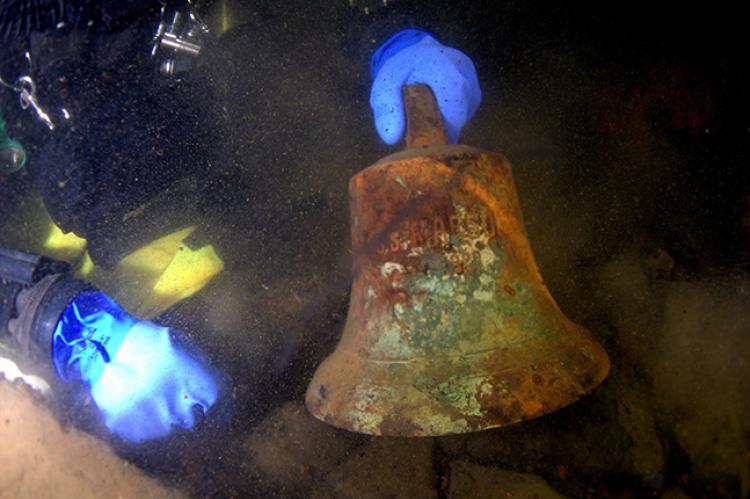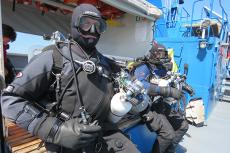Wreck Diving in Lithuania
It was pure coincidence that led my expedition team and me to Lithuania for the first time in September 2016. Our goal was to dive the battleship SMS Friedrich Carl. What we did not know before this first visit was that we would discover the “El Dorado” of pristine wrecks in Lithuania, which could keep us busy for many years.
The BSHRP team recovered a bell marked with the name SS Marsdiep 1920 from a wreck later identified as the SS Edith Bosselman, Klaipėda, Lithuania. Photo by Sabine Kerkau.
Tags & Taxonomy
Factfile
BALTIC SEA HERITAGE RESCUE PROJECT
The Baltic Sea Heritage Rescue Project is a non-profit organization founded in July 2018 in Klaipėda, Lithuania, by Rolandas Schön, Sabine Kerkau and Linas Duoblys. Its aim is to make a contribution to the protection of the past and the future of the Baltic Sea by finding and identifying wrecks and removing discarded fishing nets that pose a threat to the wreck sites and marine life.
The group works closely with the University of Klaipėda, the Lithuanian Government, the Ministry of Environment, the Ministry of Culture and the Ministry of Agriculture and Fisheries. Further cooperation includes partners such as the Historian of Navigation of the Department of History; the Ministry of Transport and Communications Klaipėda State Seaport Authority; Vytautas Grubliauskas, the mayor of Klaipėda City Minicipality; and the World Wildlife Fund (WWF).
Donate
In the last two years, BSHRP has financed their work privately. But the cost of recovering and disposing of the nets is at least €1,500 (~US$1,700) per day. These costs include an expedition and salvage ship, salvage materials (gases, cutting equipment, sacks, linen, buoys, lamps, etc.), and environmentally-sound disposal of the salvaged nets. Therefore, there is a call for donations, which may be sent to:
VšĮ “Baltijos paveldas,” Debreceno g. 33-90, LT-94166 Klaipėda, Lithuania
(Registration code 304872974; Account: Swedbank IBAN: LT31 7300 0101 5571 8642; SWIFT: HABALT22)
Volunteer
There is also a call for volunteers for the six-week ghost net project in 2019. The goal this year is to free the wreckage of the Elbing IX of fishing nets, dispose the salvaged nets properly and create a protection zone around the wreck site to ensure that the wreck remains free of nets in the future. The wreck of the Elbing IX lies at a depth of 45m. For more information, visit: bshrp.org
SMS Friedrich Carl
The Friedrich Carl is one of the most impressive wrecks I have ever seen. The sinking of this WWI vessel, the second of the Prinz Adalbert class of ships, was a great loss for the German Imperial fleet. In 1905, the Friedrich Carl accompanied Kaiser Wilhelm II several times on his Spanish and Mediterranean journeys. In April of that year, the ship accidentally collided with the British liner HMS Prince George in the port of Gibraltar, and the ship’s stern was damaged. The Friedrich Carl continued her service as the flagship of the cross-border command until 2 April 1906. From March 1909, the Friedrich Carl became a training and torpedo test ship under the commander of the Torpedo Experimental Institute in Kiel. In the winter of 1911-12, she worked temporarily as an icebreaker in the Baltic. At the end of September 1914, she was assigned to the Baltic fleet, where she participated in various operations against the Russian Navy’s Baltic fleet as part of the reconnaissance group of ships in the Baltic Sea. In her attack in the Gulf of Finland, she carried up to four seaplanes, which (as far as the weather allowed) made daily reconnaissance tours. In November 1914, the Friedrich Carl participated in an attack on the Russian naval base at Libau. On the morning of 17 November, she ran into two Russian mines, about 30 miles off Klaipėda, and the crew had to evacuate the ship at 6:30 a.m. She capsized and sank at 7:15 a.m. Seven crewmen in the torpedo room in the stern were killed. It was not until 2009 that the wreck was found by a group of Swedish divers. It lies at a maximum depth of 82m, with the upper edge of the wreck at 72m. The wreck rests on the starboard side and is in incredibly good condition. The first 100m has no damage. Portholes, cannons and even a plaque on the bow with the German Imperial Eagle are still in their original place. The wreck is not overgrown. The last 30m of the former warship is completely destroyed. The seabed on which SMS Friedrich Carl is located is so soft that about half of the ship is buried. The Friedrich Carl is about five hours by boat from Klaipėda. The visibility on the wreck is usually very good.SS Edith Bosselman
On our first visit to Lithuania in September 2016, we had the opportunity to dive an unknown wreck. We found a wonderfully intact wreck at a depth of 42 to 52m. The wreck rested on its port side. It was a small freighter with a passenger deck. In our first dive to the wreck, we discovered the ship’s bell, the helm and the bathroom in the first-class quarters. The wreck was partially covered with fishing nets. Under one of the nets, we found human remains. In May 2017, we came back to unlock more secrets about this wreck. First, we wanted to recover the ship’s bell. We hoped to find a name on it that would verify the wreck’s identity. But before we could tackle this problem, we first had to confirm with the Lithuanian Sea Museum whether we could deliver the bell there after it had been salvaged. Everything went perfectly. We recovered the bell, finding the name, SS Marsdiep 1920, on it. But then things got mysterious. Our research showed that the 1920-built Marsdiep was sold to Denmark in 1922. The new owner, AP Møller of the Maersk Shipping Company, changed the name of the ship to Jessie Maersk. Reportedly, the Jessie Maersk was torpedoed by a German submarine in 1942 off the English coast and was sunk. This has now been confirmed without a doubt. During further dives, we tried to find more evidence of the wreck’s identity off the coast of Klaipėda. We found out that the ship was loaded with coal. There were three rooms and a relatively large first-class area. There had been electricity on board; we found the switches. The instruments were probably English. The ship had a steel hull, and the bridge was made of wood. But all this information did not help us identify the wreck, because it could also have applied to the Jessie Maersk. Next, we measured the wreck. This gave us clear proof that the wreck was not the Jessie Maersk, because our wreck was ten meters short. Further investigation and research by a project member brought a determination. Our wreck was almost certainly the SS Edith Bosselman. The Edith Bosselman was originally built in 1925 for AP Møller’s shipping company, Maersk. It was called the Rita Maersk at the time. In August 1939, the Rita Maersk was sold to Eduard Bosselman. Bosselman was a merchant from Gdańsk (Danzig), Poland, and the Rita Maersk was his only ship. Due to the current danger of the war, Bosselman could not sail the ship under the German flag. He gave the ship the name "Edith" and let it continue to sail under the Danish flag. It was only in 1942, a few months before its demise, that the ship was renamed "Edith Bosselman." The Edith Bosselman was the first vessel lost in 1942 to the mines laid by the Russian submarine L3. Unfortunately, between our dives in May and August, the wreck was severely damaged. We saw the impact of big fishing trawlers everywhere. Even the human remains we had seen in May were torn away. The bridge was almost completely destroyed. vip-popki.net/enSS Tristan
In August 2017, we went in search of another victim of the mine belt. Our captain, Linas Duoblys, got a position from a local fisherman. He suspected there might be a wreck at that location. Arriving at the dive site, Duoblys found the wreck almost immediately. Our dive team was ready for the descent into the unknown. At 50m depth, the conditions were perfect; there was good visibility and no current, when we saw the wreck of a cargo ship with a passenger deck. The approximately 80m long and 10m wide wreck stood upright on the seabed at a depth of 56m. The wreck was in good condition; however, the bridge was missing. Maybe it was torn down by trawlers. At the bow, one could still admire the huge anchor. In the dining room, there was a toilet, and the kitchen looked as if it had been burnt. There were many details to discover on the wreck. The three holds were full of freight, mainly wood. We also found boxes of books. These were books by Emily Dickinson in Russian. We made two dives on the wreck and collected as much information as possible to identify it. Back on land, our colleague Thomas Weyer used this information to research the vessel online. At present, we assume that the wreck is the SS Tristan because of its cargo and its location. Final confirmation is still pending. It was on 5 February 1943 that the German carrier Tristan was sunk by a mine on her way back from Tallinn.More to discover
These two wrecks, SS Edith Bosselman and SS Tristan, have seen few divers so far, and there are so many more wrecks to investigate in the area. Technical divers can fulfill their dreams exploring the waters off Lithuania. Duoblys, the captain of the NZ 55 (one of the best dive boats in the eastern Baltic), knows countless locations where no one has ever dived. The wrecks at these locations lie at depths between 20 and 80m. Conditions at these locations are similar to those in the lakes of Austria, Germany and Switzerland. The visibility in the first 20m is usually not good; but then it is dark, yet clear below this depth. Water temperatures at the bottom is around 5°C (41°F); but, depending on the season, it can be between 1°C (34°F) and 20°C (68°F). If you are interested in exploring pristine wrecks or would like to participate in environmental projects such as the removal of the mountains of ghost nets caught on the wrecks in Lithuania, then put the NZ 55 on the top of your bucket list. ■ Special thanks go to the sponsors of the project: Fourth Element, Liquid Sports in Kiel, Mola Mola Wear, O2 Rescue, Scubapro, Scurion, Seareq ENOS System, Surface Marker, TS Sidemount, WingsAndMore. For more information, visit the website of the Baltic Sea Heritage Rescue Project at: bshrp.org. Sabine Kerkau is a German technical diver, dive writer and underwater photographer based in Switzerland. Kerkau was inducted in the Women Divers Hall of Fame in 2019. For more information, please visit: Sabine-Kerkau.com. SOURCES: Federal Archives, Freiburg (Department Military Archives) Terraine, J., (2010). Business in Great Waters: The U-Boat Wars 1916-1945. Pen & Sword University of Klaipeda Wikipedia.org Wrecksite.euDownload the full article ⬇︎



















































